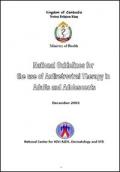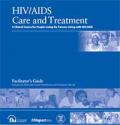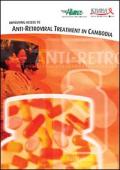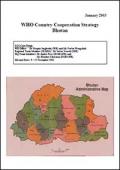Site Search
Displaying results 571 - 574 of 574

Resource | Tools,
Despite the stabilization of HIV prevalence in Cambodia over recent years there has been a dramatic increase in the number of people living with HIV/AIDS who are ill and in need of health care. This reflects the progression of HIV disease in those infected in the past, particularly the large numbers of people infected during the mid-1990s. It is estimated that the peak incidence of illness and death from HIV/AIDS in Cambodia will occur over the next few years. Each year approximately 20 000 people will develop AIDS and die unless expanded interventions are available.
This document is designed as a component in the response that is necessary to address the pressing care needs of person/people living with HIV/AIDS (PHA) in Cambodia. It is written primarily for health care workers who are involved in the care of adults and adolescents (>12 years of age) living with HIV/AIDS. It aims to provide a clear explanation of the basics of ARV therapy. It should be used as an introduction and a reference and should not substitute for comprehensive training in the use of ARV. Similarly it does not seek to address the complex operational requirements of comprehensive HIV care in general, nor of ARV provision in particular.

Resource | Publications,
Only about five percent of the 30 million people in poor countries who need treatment for HIV infection are receiving it. As the need for treatment grows, so does the demand. The June 2001 Declaration of Commitment by the United Nations General Assembly states that "Prevention, care, support and treatment for those infected and affected by HIV/AIDS are mutually reinforcing elements of an effective response and must be integrated in a comprehensive approach to combat the epidemic." Encouraged by global support for expanding access to treatment and by a decrease in the price of antiretroviral drugs, programs are increasingly seeking ways to add a treatment component to their prevention, care, and support services.
This facilitator's guide presents new knowledge and skills for delivering and organizing clinical care and treatment services for people living with HIV/AIDS. It is shaped by FHI's longstanding work in HIV-related prevention, care and support activities in more than 60 countries. Recently, FHI began supporting public and NGO efforts to deliver strengthened HIV care and support, including antiretroviral treatment (ART), in three countries at the district level.

Resource | Publications,
Cambodia is often cited as an example of how an effective multi-sectoral response to HIV, with strong political commitment and effective co-operation between government, nongovernmental organisations (NGOs), and international organisations, can impact on the spread of infection. Cambodia has an HIV/AIDS prevalence of 2.6% in the adult population (15-49 years). Government data indicates that HIV prevalence rates in some of the populations under surveillance appear to be declining. However, the current data indicates that HIV/AIDS is not uniformly distributed throughout the country and numbers of cases of AIDS and AIDS-related deaths continue to increase.
This report, building on the strengths of Khmer HIV/AIDS NGO Alliance (KHANA) and its partners, focuses on the current and future opportunities for KHANA, and other NGOs, to support access to ARV treatment for people with HIV. Recommendations are given with regard to use of existing sources of ARV, sources for increasing availability of ARV, and models for provision of ARV most likely to bring broad benefits to patients, as well as to prevention efforts, and to the health system in general.

Resource | Publications,
This WHO Country Cooperation Strategy (CCS) outlines the strategic framework for the WHO's work in Bhutan for the period end 2002 - end 2007.
The CCS is an attempt to articulate a coherent vision and selective priorities for collaboration between WHO and Bhutan. It is based on a systematic assessment of recent national achievements in health care, the current and emerging health needs and development challenges; the policies and expectations of the Government; and the activities of other development partners.





